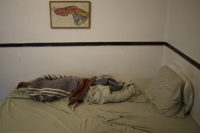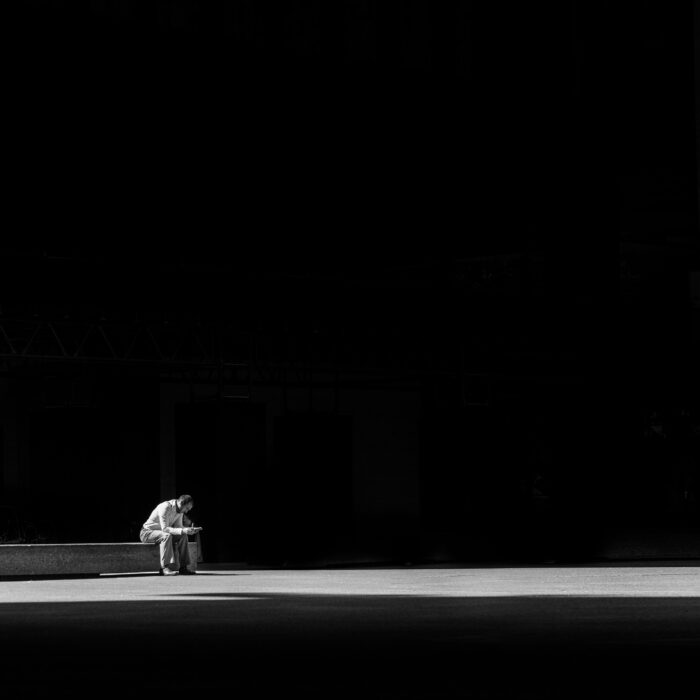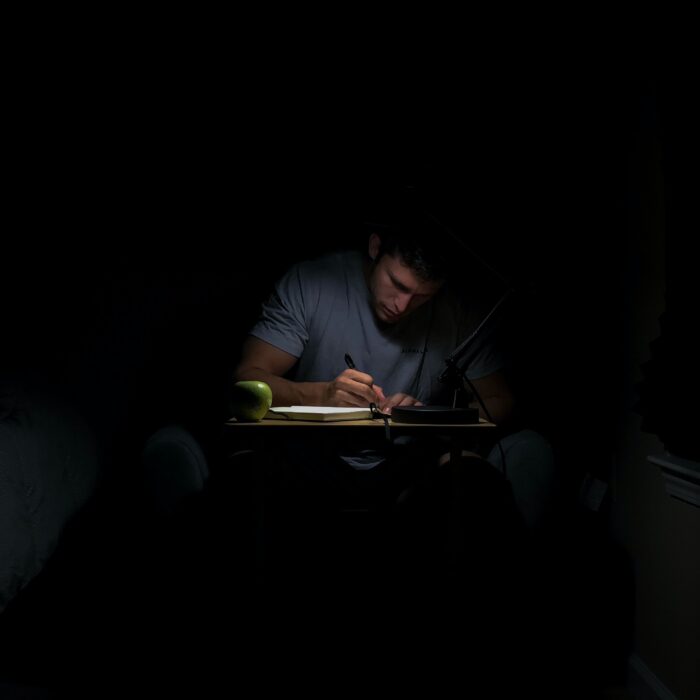You have no items in your cart. Want to get some nice things?
Go shoppingAlthough I had never considered it as anything other than a place to sleep or have sex, when I separated from my wife I not only entered into an intimate relationship with my bed, it became the center of my existence.
My wife and I slept on a futon for the last dozen or so of our twenty-three years together. After only a week or so sleeping there I had to admit (to myself, not to her) that I didn’t really like the futon at all. The beds we had before were nothing memorable but they squeaked occasionally and I liked that. Our futon was so firm it never squeaked. As firm as it was, however, over the years a hump began to emerge in the middle as we each gravitated to our own side. When the hump eventually became a mound we separated.
I spent the first night of the separation in a chintzy bed in a tiny room with paper-thin walls in a local hotel that usually charged by the hour. It was the first time I had ever stayed the night in a hotel in Mexico City and, although hundreds of couples had rolled around in it over the years, it was probably the first time someone had spent the night alone in that bed.
For the next three weeks I stayed in the house of a recently divorced friend and slept in his son’s room, surrounded by children’s books and toys, on a bed in which my feet jutted out beyond the mattress.
One day I saw a For-Rent sign hanging in the lobby of a building in the same neighbourhood I have lived in for over twenty years. I was the first one to inquire and clinched the deal. I signed the lease, the only legal, permanent real estate arrangement I’ve ever had, in the most uncertain moment of my life.
For the first month or so, splitting the week according to our post-marital arrangement, I slept with one of my twin sons on an old mattress I brought from his room in my ex-house. My older son slept in another bedroom with the other twin on a single bed in which their nanny used to sleep years before.
After a few months of living like this, my son’s guitar teacher told me he was upgrading his daughter’s bed and was going to throw the old one out. I arranged for a truck to bring it to me all the way from the south of the city and installed it in my bedroom, at which time my sons each got to sleep in their own bed.
The brand name of my bed is Intermezzo, which translates as interlude, a nod to its function as the transitional object it has become for me. I doubt it was anything special when it was first christened, but after having to support so much dead weight for so many years the mattress seems to have entirely given up its struggle against gravity. When I sit in bed for long stretches of time, which I’ve been doing a lot since my separation, my butt sinks deep into the mattress and it becomes harder each time to extricate myself.
A couple of weeks after my separation a tenacious flu made me take to bed for a whole week. Sickness brings people closer to their bed and it seemed to make it acceptable to spend more time there, even after I had recovered.
Never before have I spent so much time in bed, and never before have I slept so little. At first, the shock of the separation kept me too agitated to sleep. Having to wake up at 5:30am to get my kids off to school a couple of times a week also screwed with my sleep cycle. In addition, mosquitoes zoomed overhead and my cat strolled across my chest.
In addition to insects and animals, humans also find ways to disrupt my sleep. Car alarms, police sirens and drunken revellers pass beneath my bedroom window located on the second floor of a building in the middle of a ‘trendy’ neighbourhood. The restaurant directly below and a music studio in the apartment directly above me, however, are responsible for the majority of the noise. I can pull a pillow over my head or turn on a cheap plastic floor fan to create a buffer of white noise, but it’s impossible to drown out the vibration from the bass that rattles my bed. I often only manage to reconcile myself with sleep in the wee hours of the night, just to be woken up scant hours later by the early rumblings of the city.
Sleep deprivation produces odd effects, including brain tremors, increased mood swings and a feeling of emotional brittleness, all of which makes it even harder to sleep gently in the dark night. Afternoon naps, smoking pot and life problems combine to make me toss and turn in my bed late into the night.
It would be wrong to assume, however, judging only from the amount of time I spend there and the problems I have trying to sleep, that my prolonged time in bed reveals merely insomnia, depression and loneliness. Since my love’s bed smashed against the daily grind I often felt I‘d been set adrift in the world. At those times my bed became a life raft to which I clung to ride out waves of grief and despair, but it has also felt like a ship sailing towards self-fulfilment. I can feel more alone in my bed than anywhere else on earth, but it is where I’ve had the most intimate contact and experienced the most intense pleasure, as well.
Due to the forces of entropy and gravity, sex in a marriage can wind up restricted to a single bed and inevitably sags in frequency and intensity. Sleeping around was not only about having sex with other women but also about freeing sex up from the stultifying stuffiness of my marriage bed.
It’s curious, then, how the sex I’ve had with women since my separation has usually taken place in my own bed. Although the location has been exactly the same, each woman has brought a whole new world with her into my bed and lovemaking once again feels like an adventure. The fact that my current mattress has become concave, rather than convex like my former bed, physically reflects the difference between married and bachelor life.
When there is no woman in bed with me I jerk off occasionally. My ex-wife once caught me jerking off in our marriage bed. Instead of doing what any loving partner should do, that is, lend a hand, she got disgusted and turned her back on me. Being that most people masturbate for the first time in their own bed and continue to do so throughout their lives, it’s all quite normal and natural, especially when one is forced to handle their own pleasure. (Most of the porn people jerk off to usually takes place in a bed, as well),
As with sex, pornography and masturbation, many people’s first contact with literature also begins in bed. Kids are usually introduced to books by their parents who read them bedtime stories, and much of the pleasure of reading later in life comes from an emotional regression to childhood and its slumberland imagination, as can be seen in the way some people curl up with a book in bed.
Like young children, many adults can’t go to sleep at night without the ritual of reading in bed. My ex-wife’s literary consumption was almost completely restricted to the few paragraphs of popular literature she read in bed to help her fall asleep at night (although the book clutched in her hand often seemed like a defence against any unwanted advances on my part). The fact that she never read anything I wrote used to bother me, although perhaps I should be grateful she never used my writing as a soporific.
Since the separation, I’ve begun reading once again, something I had practically given up years ago. I’ve even started to read in bed, something I never did before, though it doesn’t seem to help me fall asleep at all (masturbation is more effective).
Books and beds are quite natural bedfellows. White sheets resemble nothing so much as a sheet of blank paper, and the key moments in the life of a person (birth, childhood, sex, procreation, disease and death), like the keys moments in novels, tend to occur between covers.
Writers, like prostitutes, are among the few professionals who can actually work in bed. James Joyce used to write on his belly in bed, Proust spent the end of his life writing Remembrance of Things Past in a big brass bed (Swann’s Way begins: “For a long time I used to go to bed early.”), and Truman Capote called himself a “horizontal writer.”
Although I had never written a word in bed before, nor had I ever kept a diary, I began to write about my life that night in the cheap love hotel, banging away on my laptop in an attempt to figure out how I had wound up alone in that bed. I continued to write all the way until the divorce had been finalized a few months and 400 single-spaced pages of autobiography later.
As one of my only contributions to my former home’s décor I had hung upon the wall facing our marriage bed a framed piece of art in which a man who looked much like me lay in bed staring back at me with his eyes open. My wife, sick of having another unshaven, emaciated and depressed man hanging around her bedroom, eventually asked me to take the work down from the wall, a clear foreshadowing of our separation (that is, had I been able to read the writing on the wall).
The work of art, which I now have hanging over my new bed, is a reproduction of an Egon Schiele self-portrait he painted in prison during a three-week stay for abducting, showing pornographic material to and having sex with one of his underage models (he often painted his models naked in bed while standing above them on a ladder).
The text accompanying Egon’s self-portrait reads “Hindering the artist is a crime, it’s murdering life in the bud.” (I often wondered if the last word wasn’t a typo.) It took getting divorced to awaken me from my dogmatic slumber and to realize that, by limiting the use of my bed almost exclusively to sleep, my life as an artist was being hindered by such a routine lifestyle.
Egon’s self-portrait shares the walls of my bedroom with a series of large photographs of love motels in the Dominican Republic. I took the photos just before and exhibited them in two art museums in Mexico just after my separation. To accompany the photos, I had a large bed brought into each museum for visitors to sit on and from which to view the work, accompanied by a large overhead mirror, towels folded in the shape of a swan and a bowl full of condoms.
This same series of photos was also exhibited for one month in the Hotel Oslo, one of the most traditional love hotels in Mexico City. The owner generously gave me the use of four rooms plus a suite (with a Jacuzzi, a round bed and an overhead mirror) in which to hang my photographs. At the opening I took portraits of people in different beds in different rooms in front of different photographs of mine.
While doing these portraits, I noticed how certain attractive women responded to having their picture taken by me in bed. Afterwards, a couple of these women passed through my own bed, where I continued to take photographs of them. Photographing attractive women in bed, my own and in hotels around the city and in other cities in other countries, has since opened up a new series of work for me while at the same time enriching my personal life.
Although I’m enjoying the time I spend with women or by myself, writing, in bed these days, in the not-so-distant future I will get probably sick and be taken to bed to await death. During the first month or so after my separation, late at night, alone, crazed by insomnia, I sometimes imagined myself sinking so deep into my mattress it eventually engulfed me and became my tomb.
Regardless of its inevitability, I’m not ready to assume the permanent horizontal nor rest in peace quite yet, and thus before I die I think it a good idea for me and my bed to part. We are still on good terms and I make a point of visiting it at least once a day, more often when I’m with company, but I no longer look to my bed as either a transitional object or the base of my existence. Even if we no longer have such an intimate relationship, I still dedicate this text, of which it is the protagonist and the place where I wrote every word of it, to my dear bed

About Kurt Hollander
I'm originally from NYC but have been living in Mexico City for twenty five years. I am the author of Several Ways to Die in Mexico City, and have recently contributed to The Guardian, Guernica, Vice and Weapons of Reason, among others. I am also a documentary and fine art photographer.




